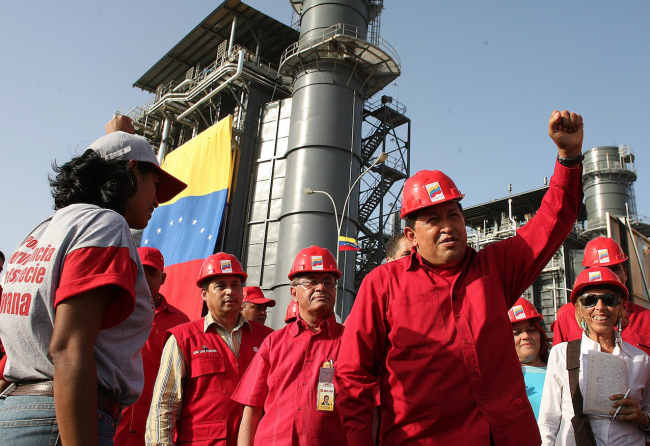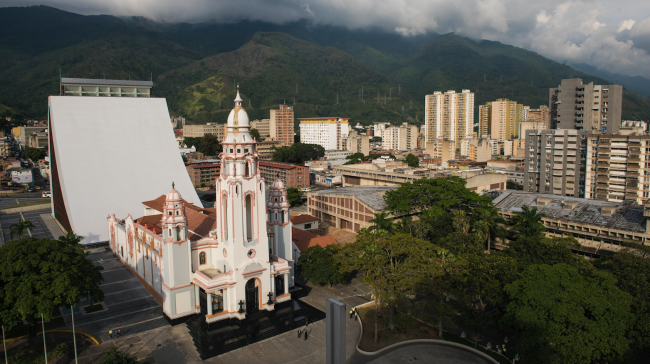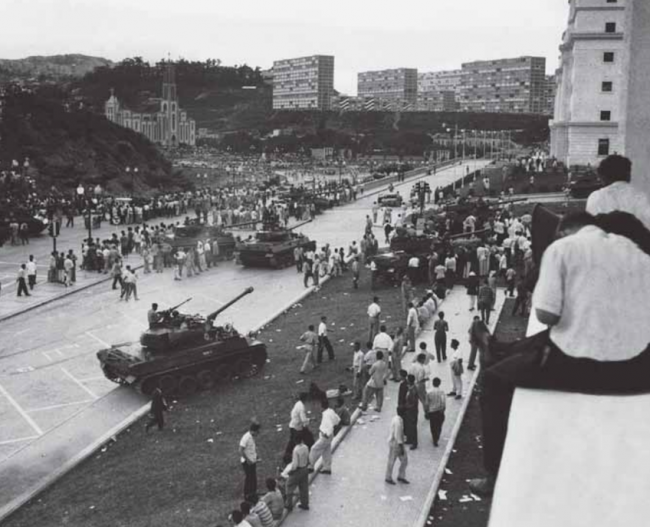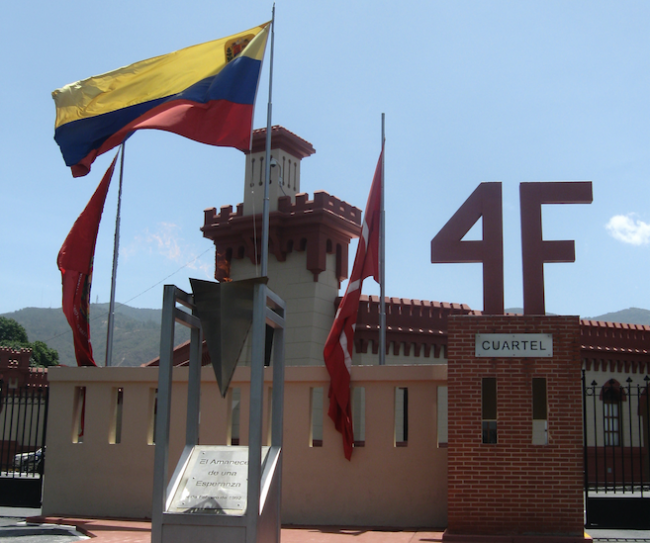
This piece appeared in the Spring 2022 issue of NACLA's quarterly print magazine, the NACLA Report. Subscribe in print today!
In February 1999, Hugo Chávez took office as president of Venezuela after winning elections in a landslide. It capped a stunning comeback for the former lieutenant colonel, who seven years earlier had led a failed military coup against a widely unpopular government presiding over a deep economic downturn. Chávez’s electoral win also marked the collapse of a 40-year political order once hailed as Latin America’s most stable and prosperous liberal democracy. In its stead, Chávez and his Bolivarian Revolution—named in honor of Venezuela’s 19th century independence hero Simón Bolívar—promised to usher in a new republic where those left out under the previous regime would take center stage.
Twenty years later, Chávez is dead, his hand-picked successor is in power, and Venezuela is gripped by staggering crises on all fronts: severe food shortages, skyrocketing poverty, rampant violence. Amid a public health sector collapse, once-eradicated diseases have resurfaced; amid a general infrastructure collapse, millions fend without water or electricity for weeks at a time; amid crippling U.S. sanctions, an already catastrophic economic crisis has grown exponentially worse. Meanwhile, oil production—the country’s primary source of revenue for nearly a century—has plummeted to pre-World War II levels amid corruption and mismanagement of the national oil company. By some estimates, nearly 6 million people from all walks of life—nearly 20 percent of the population—have departed the country in the last decade by plane, bus, boat, or foot, seeking opportunities or relief elsewhere. It is the second largest global migration in recent years following only that of war-torn Syria.
How and why Venezuela reached this point is the subject of fierce debate. For some, the answer lies with Chávez and his eponymous movement. From the outset, they claim, Chavismo pursued an authoritarian project cloaked in the language of popular democracy but underlain by cronyism, repression, and spendthrift handouts to the poor. For others, Venezuela’s current situation stems from resistance by domestic elites and their backers in the U.S. government. From the start, they argue, local elites and U.S. officials saw in Chavismo a threat less to democracy than to their power and influence at home and in the region; these forces then used democratic and antidemocratic means to undermine Chávez’s efforts to redistribute wealth, implement socialism, and challenge U.S. hegemony in Latin America and the world. Still others blame the nation’s dependence on oil. For nearly 100 years, they note, oil has lured governments of different ideological stripes into cycles of boom and bust, overspending in times of plenty only to contend with accumulated economic, social, and political debts in times of scarcity.

Taken together, each of these explanations is accurate. But more often they are deployed independently, creating an incomplete picture of the Chávez era aimed less at explaining than at apportioning or deflecting blame. In part, incomplete renderings reflect intense polarization that for over two decades has turned Venezuelan politics into a winner-take-all conflict between Chavistas and anti-Chavistas. More broadly, they belie the complex, contingent factors leading to the collapse of one political order, the rise of another, and eventually, the onset of one of the worst humanitarian crises in Latin American history.
This sweeping account of Chávez and Chavismo offers an interpretation that emphasizes the evolving nature of both. Rather than seeing Chavismo as a break with the past, it considers how continuities between the Chávez era and the political order it replaced undermined its own stated efforts to implement revolutionary change. Rather than seeing Chavismo as an authoritarian project from the start, it considers how antidemocratic moves by Chávez and his opponents created opportunities and incentives for cementing state control that Chavismo eagerly seized and later suffered from. Rather than seeing the United States as an omnipotent force over the region, it understands Chavismo and the international alliances it formed as agents in their own right who shaped, responded to, and suffered from larger geopolitical shifts. Rather than seeing oil as the main driver of Venezuelan politics and society, it considers how highs and lows in commodity prices exacerbated already deep contradictions in the heart of Chavismo.
Seen as a whole, Chavismo takes shape less as a single movement linked by an overriding ideology than as an assemblage of often contradictory movements and ideologies that developed in at least four distinct stages: a first stage preceding Chávez’s first electoral triumph in 1998, which brought the collapse of one political order and the slow emergence of an inchoate, alternative vision combining reformist militarism, revolutionary vanguardism, and Bolivarian nationalism; a second stage between 1999 and 2006, marked by pitched battles between Chavistas and anti-Chavistas over competing meanings of democracy and culminating in the consolidation of Chávez in power; a third stage between 2006 and 2013, where Chávez’s focus shifted to promoting “socialism of the 21st century” in Venezuela and abroad in the context of a historic commodity boom, accentuating major contradictions within Chavismo; and a fourth stage, beginning with Chávez’s death in 2013 and still in gestation, marked by the rise of an authoritarian, one-party state under Chávez’s successor, Nicolás Maduro. Though each stage created and responded to new challenges and opportunities, all were thread by the changing whims of its charismatic, polarizing leader, in life and long after his death.
The Epic of Puntofijo: Climax, Crisis, Collapse (1958-1998)
Most Venezuelans first heard of Hugo Chávez during a hastily organized press conference that should have marked the end rather than the start of his political life. In the predawn hours of February 4, 1992, Chávez commanded a regiment of Army paratroopers and seized control of the former Defense Ministry overlooking the Miraflores presidential palace in Venezuela’s capital Caracas. From there, he would direct both the takeover of the heavily guarded palace and the arrest of the country’s president. By daybreak, the coup had failed, and Chávez was in custody. Granted brief airtime to broadcast his formal surrender, Chávez took responsibility for the coup and called on troops loyal to him to lay down their arms. “New situations will come,” he told them and the nation before being hauled to jail, “and the country must definitively get on the path to a better destiny.”
Though the coup failed, it shocked those in and outside Venezuela who had long upheld its political order as an “exception” in the region. Since the 1960s, military rule or civil war had plagued much of Latin America. But Venezuela had emerged as a model of representative government following the ouster of dictator Marcos Pérez Jiménez in 1958. Infighting between elites had doomed earlier efforts at instituting democracy in Venezuela. Determined to avoid the same fate, in 1958, leaders of the country’s major political parties resolved to share power in a pact known as Puntofijo, named after the Caracas residence where it was signed. That agreement became the framework for a political system founded on the principle of inter-elite pact-making through strong political parties, capable of channeling and adjudicating demands from business, labor, and civil society via competitive multiparty elections.

In the ensuing years, Venezuela’s pacted democracy proved remarkably resilient. In the 1960s, Venezuelans overwhelmingly supported the budding political order both in the streets and at the ballot box. Challenges emerged both from right-wing reactionaries seeking a return to authoritarian rule and from left-wing guerrillas seeking to implement a socialist revolution inspired—and at times underwritten—by Fidel Castro’s Cuba. In 1969, following a decade of governance by the social democratic Acción Democrática (AD) party, Rafael Caldera of the Christian democratic COPEI party narrowly won elections and took office as president. It marked the first peaceful transfer of power to an opposition party in Venezuelan history, fixing the country’s standing as an island of representative democracy in a continent more and more marked by Cold War-era dictatorships and fratricidal conflict.
When the 1973 Mideast oil embargo sent crude prices to historic highs and filled Venezuela’s coffers with a windfall of petrodollars, the newly elected government of AD’s Carlos Andrés Pérez embarked on a spending spree meant to catapult Venezuela into first-world status. Mass investments in social programs, construction projects, and state-owned industries helped to slash poverty, boost consumerism, and grow the middle class. The peak came in 1976 when Pérez nationalized Venezuela’s oil industry. Whereas prior such moves elsewhere had stoked anti-communist fears and provoked a backlash from the United States and domestic private sectors, Venezuela avoided tensions by paying millions in compensation and by modeling its new national oil company, PDVSA, after the private corporations that had built the country’s oil sector since the 1910s. Rather than serving partisan interests, PDVSA would run as a quasi-private, largely autonomous company, paying dividends to the state but otherwise privileging technical expertise focused on producing and exporting oil. Coupled with its increasingly consolidated electoral democracy, the 1970s boom marked the apogee of Venezuela’s Puntofijo era.
Agony followed. Oil wealth had enabled Pérez to spend lavishly. It also saddled Venezuela with massive debt that relied on a continuing windfall of oil revenues to service. But by 1981, crude prices collapsed as new energy regulations in oil-consuming countries coincided with a glut of supply from oil-producing ones. When Mexico defaulted on its own oil-boom incurred debt in 1982, global lending markets dried up, and Venezuela’s coffers shriveled under the weight of loan obligations abroad and a bloated state apparatus at home. In the ensuing decade, successive COPEI and AD governments pumped ever-dwindling reserves into debt payments. Poverty rose as social spending collapsed, inflation ballooned as the currency lost value, and unemployment grew as investments fell. Meanwhile, the oil bust exposed other problems that the boom years had simultaneously fueled and masked: corruption had spiked when petrodollars flooded the country, and while per capita income had grown, so had inequality amid uneven distribution of oil wealth.
Economic downturn was a blow. But the deeper crisis was political, and this one struck at the very heart of the Puntofijo project. In the 1960s, consolidating representative democracy against extremist threats from right and left had required limiting democratic participation in favor of a strong central government. But once consolidated by the early 1970s, calls grew from civil society, youth sectors, and emerging political leaders to “democratize” Venezuelan democracy by decentralizing state power and promoting greater citizen participation. Instead, the oil bonanza further concentrated power in the national government—now owner of the country’s main source of revenue—and by extension, in the country’s two principal political parties, AD and COPEI. It also raised expectations about what the state could and should deliver—expectations that the oil bust made untenable.
A vicious cycle ensued: as austerity policies swelled the ranks of the poor and squeezed the middle class, mounting grievances fell on a political system—the national government, major parties, and elected officials—that was ever less able to respond, eroding confidence in a political order ever more committed to austerity to weather the financial storm. As the social pact between political leaders and citizens frayed, renewed calls to reform the state resulted in a presidential-level commission (COPRE) charged with finding ways to decentralize power and expand citizen participation. But whereas earlier calls in the 1970s had surfaced in a climate of optimism and opportunity following the consolidation of representative rule, now reform efforts would move forward in a climate wracked by intersecting economic and political crises.
These twin crises came to a head in 1989, a year that began with a familiar face in power. Carlos Andrés Pérez had just returned to the presidency after an electoral campaign premised on reprising the glory years of his first term. In particular, Pérez had placated voter fears by promising to forgo foreign loans conditioned on greater austerity. But once in office, he reneged. Calling it “El Gran Viraje” (The Great Turnaround), Pérez announced an ambitious plan to negotiate an emergency loan with the International Monetary Fund (IMF) and transform Venezuela’s economy by privatizing state-owned industries to increase efficiency, devaluing the currency to court foreign investment, and slashing subsidies to reduce state spending, among a slew of other structural adjustments. Cuts to gasoline subsidies struck deepest, spiking the price of food and public transit and, more broadly, challenging Venezuelans’ long-assumed birthright to the world’s cheapest fuel. In February 1989, mass protests erupted, and the government responded by imposing a curfew, suspending constitutional rights, and deploying the military to regain order. By the time it was over, an estimated 1,000 to 1,500 civilians had died in what the Inter-American Court of Human Rights later ruled was a state-sponsored massacre.
The Caracazo, as it came to be known, marked a bloody watershed in Venezuela’s spiraling economic crisis. And by year’s end, the country’s simmering political crisis would also reach a critical point. In December, Venezuelans went to the polls in the country’s first-ever elections for mayors and governors, posts previously filled by presidential appointment. Direct local elections should have been a high point in the nation’s democratic history: it had been the COPRE’s primary recommendation to expand representation, promote participation, and decentralize the state. But in a context of deep austerity, decentralization offered greater representation with little economic power, undermining rather than bolstering popular belief in democratic accountability. Coupled with the Caracazo months earlier, and with compulsory voting eliminated as part of the COPRE reforms, abstention ruled the day. As the brunt of economic measures took hold in the ensuing months and years, the Gran Viraje and political decentralization—reforms meant to generate confidence in representative rule—instead had the opposite effect, eroding faith in the promises of the liberal democratic order founded in 1958.
Against this backdrop, Chávez undertook to stage a coup d’état in February 1992, the first such attempt since the early 1960s. The Caracazo had punctured the social pact between leaders and populace. But the coup revealed fissures deep within the pacted system itself and among the military and political elites. Speaking in Congress on the afternoon of the coup, former President Rafael Caldera argued against a new suspension of constitutional rights: “It is difficult to ask the people to self-immolate for liberty and democracy,” he intoned, “when they think that liberty and democracy are incapable of feeding them.” It marked a stunning admission of failure from one of the architects of Puntofijo, especially since most leaders had shown little will to accept responsibility for mistakes. Pérez proved particularly unyielding in the face of mounting crises, and after another, bloodier coup attempt failed in November 1992, Congress impeached him on corruption charges. Found guilty, Pérez spent the remainder of his presidential term in jail.

Pérez’s impeachment and imprisonment seemed a victory for democratic accountability and institutional order. In fact, it proved a last gasp for Puntofijo. In late 1993, an aging Caldera was reelected president, not as leader of the COPEI party he had founded decades earlier and with which he had helped build pacted democracy, but representing a ticket of smaller parties that emerged in the wake of decentralization. Caldera’s victory over AD and COPEI marked the end of two-party hegemony. Coming after Pérez’s reelection, it also exposed how Puntofijo had failed to cultivate a new generation of political leaders to represent a changing electorate. And, owing as it did to a coterie of parties linked primarily in their support of Caldera, his election signaled the emergence of an electoral politics based more on personal appeal than on party or ideological affiliation.
Once in office, and lacking strong party support in a system designed around strong parties, Caldera floundered. Structural adjustments under Pérez had promised a great turnaround, but by 1994 the economy showed few signs of recovery. Instead, as poverty, inflation, and unemployment continued to rise, half of Venezuela’s largest banks failed in a massive corruption scandal, wiping out already deeply devalued savings and striking a further blow to a long-battered middle class. When several bank executives were found to have fled with millions of dollars, it revealed the state’s incapacity even minimally to oversee the very private sector it had billed as the answer to Venezuela’s problems. Meanwhile, in a bid to inject badly needed resources into the country’s oil industry at a time when crude prices reached near record lows, Caldera moved to “open” PDVSA to private investment. In effect, this move reprivatized key areas of the national oil company whose creation 20 years prior had stood as pacted democracy’s crowning achievement. For a generation of Venezuelans raised to take pride in PDVSA, its reprivatization marked a final blow to the promise of Puntofijo. As Caldera hobbled to end of his term, the question was not when something new would emerge, but what.
Chavismo as Bolivarian Revolution: Origins and Onset (1954-1998)
That Chávez would be the one to usher in Puntofijo’s final demise was far from certain, especially as he sat in jail following his failed coup. Nor did Chavismo reflect a well-formed political project at its outset. Instead, Chávez’s rise to power, and what Chavismo would come to mean in its initial stages, followed an unlikely path that inversely mirrored Puntofijo’s precipitous collapse in the 1990s. For Venezuelans, especially those most affected by the decade’s spiraling crises, that collapse centered around two key demands born of the crucible of pacted democracy’s terminal phase: achieving genuine democratic accountability via effective political participation and mitigating the effects of structural adjustment by rebuilding state capacity. These demands informed the early core of Chávez’s and Chavismo’s appeal to an electorate in search of an alternative to pacted democracy.
And while the outcome may have been uncertain, it made sense that Chávez became the standard bearer for political change. He embodied both the achievements and the shortcomings of the Puntofijo era in important ways. Born in 1954, Chávez was part of a generation of Venezuelans raised in the fray of the 1960s democratic consolidation. He came of age during Puntofijo’s heyday in the 1970s and grew into political consciousness in a climate of deep crisis in the 1980s. Dark-hued and brought up in a family of modest means in the country’s long-impoverished, cattle ranching llanos (plains) region, his background stood apart from that of many of the nation’s political and economic elites and more closely reflected the plight of the growing ranks of the country’s poor, mestizo, and disenfranchised popular sectors. But Chávez had also benefitted from opportunities for advancement provided by liberal democracy. In 1971, he joined a professionalized military and rose through its ranks to secure an education and middle-class status. Like many upwardly mobile Venezuelans in the 1970s oil boom, Chávez harbored an affinity for U.S. popular culture, in his case rooted in dreams of playing Major League baseball owing to his standout skills in the sport. Yet as a child of the llanos, a region steeped in folklore as the cradle of independence, he also nurtured a strong nationalist streak that deeply informed his sense of self.
Read the rest of this piece, available open access for a limited time.
Alejandro Velasco teaches Latin American history at New York University. He is the author of Barrio Rising: Urban Popular Politics and the Making of Modern Venezuela and was executive editor of NACLA from 2015 through 2021.

